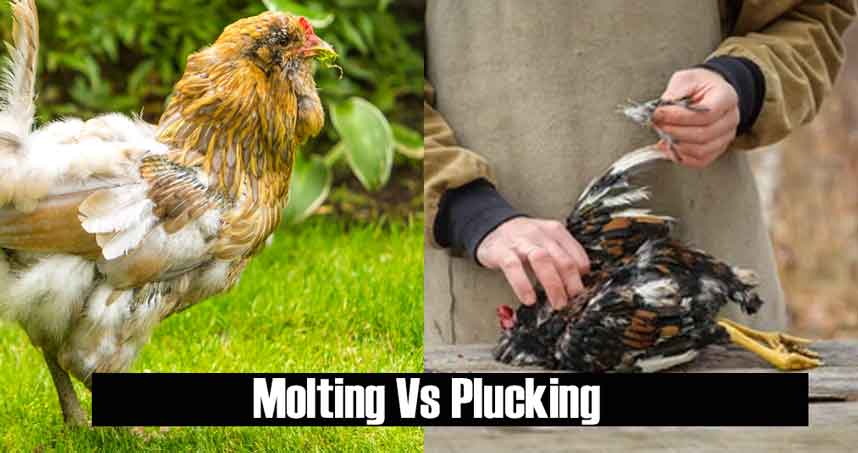Feathers play a vital role in every bird’s life, and they can replace in two different ways, molting and plucking. While molting is a natural process, birds remove it themselves, and plucking has to be done by you. However, they both are essential in different ways, and understanding the differences will help you to take care of the birds properly.
Old and damaged feathers are replaced through molting. And you have to pluck the feather when you want to eat the skin. Molting occurs seasonally, and plucking can happen whenever you need it.
Differences Between Molting and Plucking
Molting
molting occurs naturally in birds once or twice a year. It’s a critical part of birds’ biology. The process helps to regrow strong, new, and healthy feathers. The molting time depends on the environment and hormones. The molting times of wild birds and pet birds are different. Also, pet birds have longer molt because they do not get much sunlight and environment like wildlife.
Molting occurs in various bird species, and the timing can vary on the species and age.
What Does Molting Look Like
During molting, the feathers shed symmetrically. For example, if one feather falls out from the right side of the body, other feathers will fall out from the left side. This will happen naturally to balance the bird’s body weight.
When the feathers fall out, new feathers start to increase. The feathers will be everywhere, and their plumage will look damaged. Sometimes birds actively remove the feather by preening. When the new feathers grow, the plumage will look uneven and messy, as not all feathers will be replaced simultaneously. The new feathers will look like pin feathers full of blood vessels. The pin feathers are small and darker in structure.
Some bird experience itching during molting so that they will do preening often. Also, their flight capabilities reduce due to the loss of feathers. Some birds undergo complete molds at a time, and some experience half molds, which depend on species, time, and nutrient intake.
Side Effects of Molting
molting is a natural process that occurs in various birds; it has few side effects. Molting is beneficial to replace the old and damaged features to grow new and healthy on instead. You don’t have anything to do during the molting process. The birds may change their behavior but don’t worry about it. They will be ok after some time, especially during the molting process.
But if you see excessive feather loss for a long time, it’s time to see a vet.
Plucking
Plucking is manually pulling out healthy feathers by birds or humans. Birds engage in plucking when they are stressed, bored, or ill. Sometimes they pluck their feather when they have health problems or want attention. This is a common habit of most bird species, making them look messy and unhealthy.
Plucking manually harm the follicle, and feather may never grow in that area due to tearing or damaging the skin. It’s essential to stop them from plucking when they are doing it excessively. Sometimes the birds get addicted to it and won’t stop until you stop them. The easiest way to distinguish between plucking and molting is plucking leaves bare patches on the skin
What Does Plucking Look Like
A plucking bird it looks like they are preening. But the bird will tug only some specific areas aggressively because a healthy feature is firmly attached to its skin, so the bird has to pull it with force, which leads to the area being damaged or permanently bald.
The bird first grips the base firmly and pulls the feature swiftly in the opposite direction. That creates a small opening or hole in the skin. Human plucking means they use a chicken plucking machine or tweezer to grasp the feather at the root and pull them out. This can make the skin reddish or slightly swollen.
Plucking is painful for the birds.
Side Effect of Birds Plucking
Feather plucking or self-mutilation is not natural, and it has several side effects on the birds, such as,
- Excessive feather plucking leads to plumage damage that affects the bird’s appearance.
- Plucking can cause itching, irritation, and damage to the skin. Constant plucking makes the skin reddish and causes skin injury.
- Plucking can also lead to skin infections. Bacteria can quickly attack damaged areas and make the birds sick.
- Excessive plucking can cause permanent baldness in the area.
Is Molting Painful for Birds?
Molting is a natural process that replaces old feathers and grows new and healthy ones. Almost every bird faces this cycle once in a life, and the time depends on hormonal changes, environment, etc. It is not considered painful for the bird, but they will feel discomfort, stress, and weakness. Sometimes their scalp will be itchy when the new feather grows. Molting helps to grow new feathers and increase their flight capabilities.
Is Molting Good for Chickens?
Molting is beneficial for the chicken as it helps to replace the old and damaged feathers so the new feather can grow. Molting improves feather quality and regulates body temp. After molting, the chicken gets more energy for egg production too. The best thing you can do is, feed your chicken highly nutritious food during the molting time to make the process easy for them.
